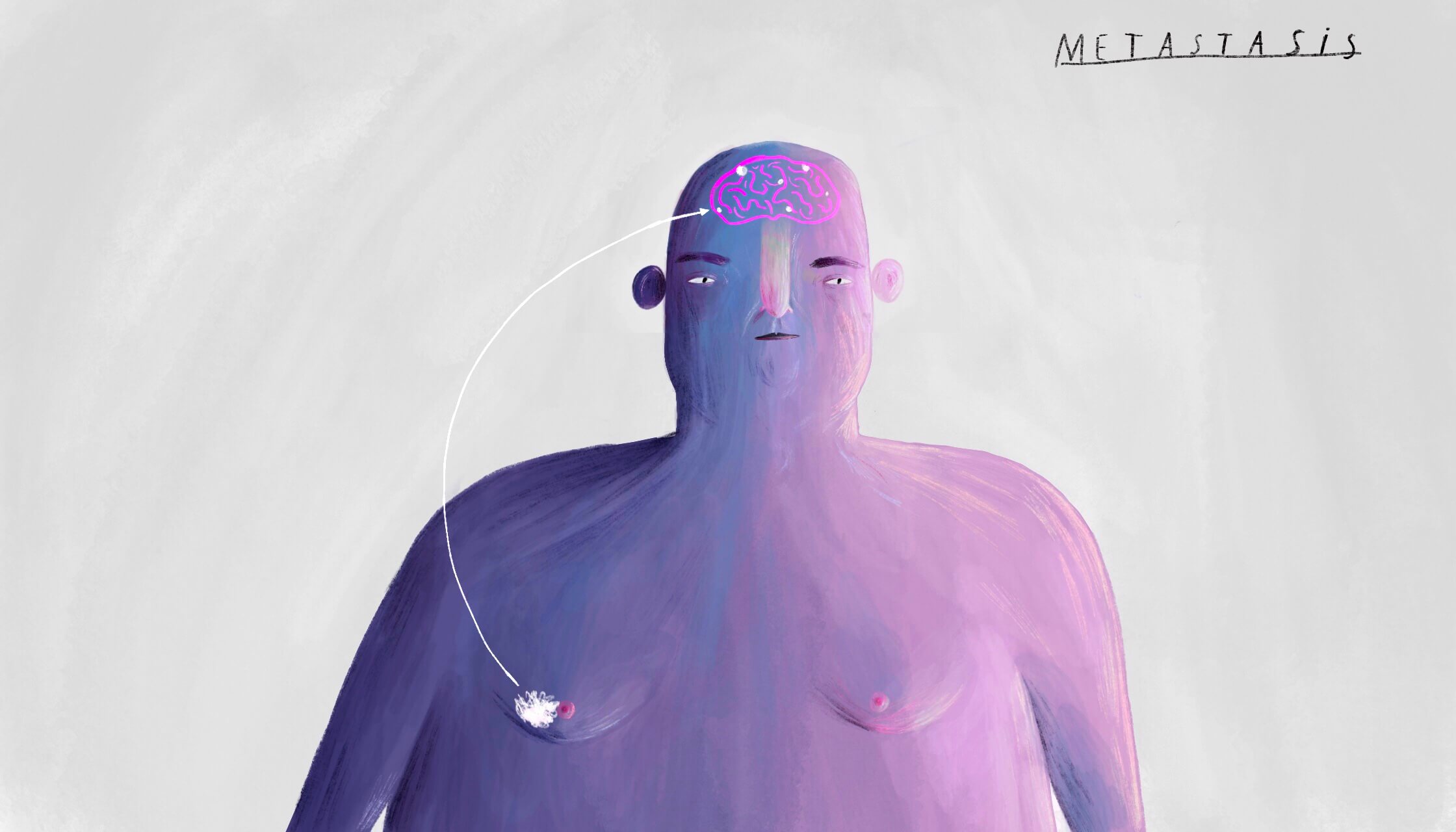Metastatic brain tumours
or tumours that have spread via another body part.
Find out more about metastatic brain tumours, or tumours that have spread from another body part to your brain.

Neurosurgeon Brisbane
Metastatic brain tumours key points
- Half of all the brain tumours are metastatic, meaning that they have spread from another body part via the bloodstream to the brain
- Headaches, stroke-like symptoms and seizures are the 3 most common symptoms caused by brain tumour.
- Depending on the type of cancer, you will undergo either brain tumour surgery, drug treatment and/or radiotherapy, or a combination of those three.
Metastasis | Brain tumour surgery Brisbane
What is it?
Metastases are the most common type of brain tumours in adults. 50% of all tumours that occur in the brain are metastatic.
Metastatic’ means that a cancer has spread from another body part via the bloodstream to the brain. It is also called a ‘secondary’. This is very different from a primary brain tumour which originates within the brain itself.

Neurosurgeon Brisbane
In reality it is actually quite rare for cancer to spread to the brain. For example in only about 15% of women with breast cancer will the tumour spread to the brain. The numbers vary for the different cancers that spread to the brain.
The cancers that do spread to the brain include breast cancer, lung cancer, melanoma, kidney cancer and gut cancer. In contrast however, prostate cancer almost never spreads to the brain.
Common brain tumours
Is it common, do other people get it?
For a neurosurgeon, a metastasis is the most common brain tumour we see. However, for the general community it is very rare to hear about it. Though recent awareness and research charities have made people more aware of it is still uncommon to know someone who has had a brain tumour.
For example, about 16,000 people get melanoma in Australia each year (out of a total of 26 million Australians), and of these, only 8,000 of these will spread to the brain. So for neurosurgeons and oncologists that’s a lot, but for the general community, that’s very rare.
Brain tumour symptoms
What are the symptoms?
There are only 3 symptoms that can occur:
- Headaches due to pressure on the brain from the tumour pushing on the brain and causing swelling in the brain. This pressure can also make you feel vague and somewhat confused.
- Stroke-like symptoms. You may have problems speaking if the tumour is pressing on the speech centre of the brain. If it is pushing on the movement part of your brain then you may have weakness in your face, arms or legs. Similarly, if it is in the vision part of your brain then you may have blind spots in your vision, and keep running into things.
- Seizures. There are different types of brain tumours that are more likely to cause seizures, however occasionally a metastasis can cause a seizure. It is very rare for this to lead to an epilepsy problem long term.
Brain metastases are a very serious condition and without urgent treatment it will be fatal. Fortunately modern chemotherapy, immunotherapy, stereotactic radiosurgery and neurosurgery have improved the situation for patients significantly. It is still very serious however.
Brain tumour surgery Brisbane
How is it treated?
The three types of treatment for brain metastasis is:
- Surgery
- Chemotherapy or immunotherapy (drug treatment)
- Radiotherapy (x-ray treatment).
Depending on the type of cancer it will be a different combination of these.
Do I need surgery when I have a metastatic brain tumour?
There are 3 reasons that surgery is required.
- To get a diagnosis.
It is virtually impossible to know 100% what type of cancer something is just by looking at the scans. The only way to be 100% is to get some samples and send it to the laboratory where they can do a series of tests on it and get the answer once and for all. So sometimes it is necessary to do a brain operation just to get some samples. - To relieve symptoms of pressure.
By reducing the size of the tumour it is possible to significantly improve your symptoms like headache. If the tumour is causing stroke-like symptoms then it may also be possible to improve this by removing as much of the tumour as it is safe to do so. So this is all about improving your quality of life. - Oncological.
This means length of life. Sometimes, by removing most or all of the tumour your overall prognosis gets a little bit better. Furthermore, by removing it, it will make the effects of chemotherapy or radiotherapy more positive.
You will notice I’ve said “remove most of the tumour.” You may wonder why the whole tumour isn’t always removed, after all that would make sense, wouldn’t it? Well, in an ideal world, yes. And in the lung, the bowel or the skin for example, this can be done. But in the brain you can’t. It isn’t always possible to remove everything because it may risk vital parts of the brain that are next to, or surrounding the tumour.

Neurosurgeon Brisbane
We have very good evidence now that if you have a stroke during the surgery as a result of trying to remove every last bit of the tumour then your overall prognosis actually gets worse, not better.
It is very clear that as much should be removed as possible without causing a stroke.
When I assess you I will be able to accurately determine if surgery is best for you and how much I will be able to safely remove and what this means for you overall.
It is horrific news to find out you have a brain tumour, and it is vital that you feel in control as much as possible, and that includes knowing everything you can going into treatment. I will take you through this.
Does the treatment work?
This depends on the type of cancer. I will take you through this once we have some answers including what type of tumour it is.
Brain tumour operation risks
Is this treatment safe?
It is vital that you are in control of as much as possible, and that includes knowing everything you can going into treatment. I will take you through this and all the risks and benefits of treatment.
There are risks to treatment. Fortunately with modern technology and equipment the risks are significantly less than what they used to be 20 or even 10 years ago.
Here are the main risks of surgery for brain tumours:
- Risk of stroke
- Risk of epilepsy
- Bleeding needing a second operation to remove the blood clot
- Infection requiring antibiotics or a second operation to washout the infection
- Risk that the tumour cannot be removed completely. Sometimes tumours are deliberately left behind so that you are not put at risk of stroke.
Neurosurgery has come a long way in modern times. Now surgery can be done quite routinely and with relatively quick recovery. Remember, most of the time we are trying to improve your quality of life by removing the tumour so performing an operation that makes you no better, or even worse is not appropriate. Performing big surgery to remove everything at all costs (to you) is certainly not a modern way of thinking. I will take you through everything when I see you and explain how I will get you through this as good as possible.
Brain surgeon Brisbane
What should I do now?
News of a brain tumour for you or family or friends is devastating. It’s usually news that comes like a freight train out of nowhere, and there will be a million questions, including “will I die?” .
You will be automatically referred to a specialist by your GP. If you would like me to review your case then please contact my team immediately.
Ready to make an appointment?
Ramsay Specialist Centre
Suite 325
Newdegate St
Greenslopes QLD 4120

